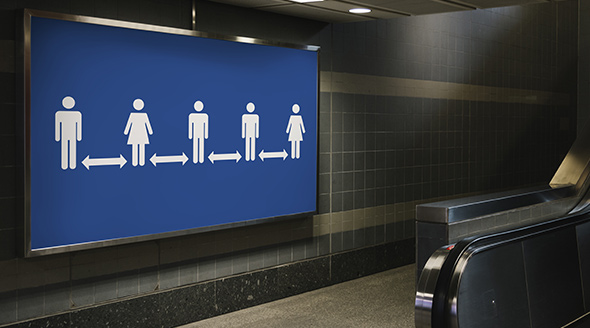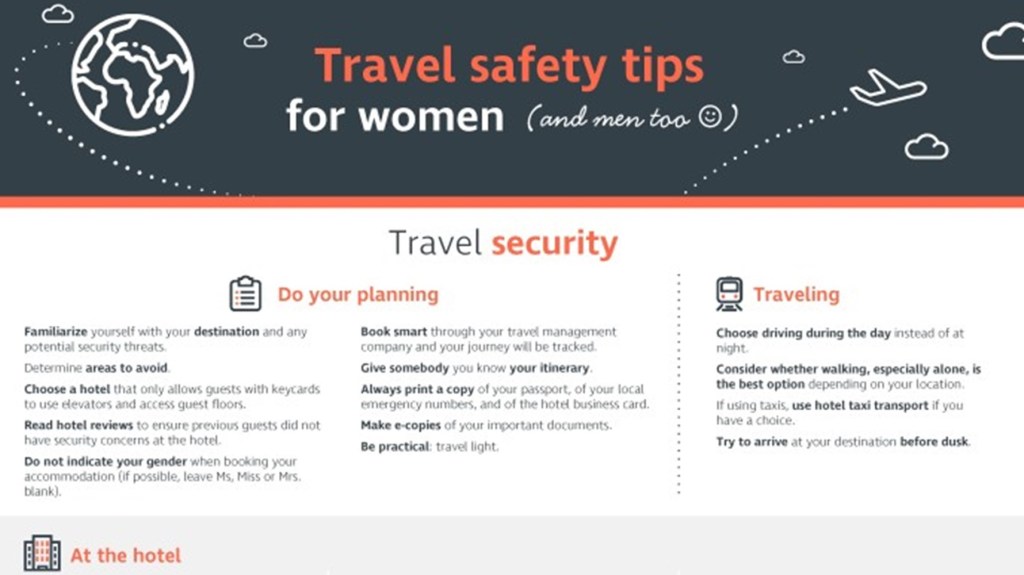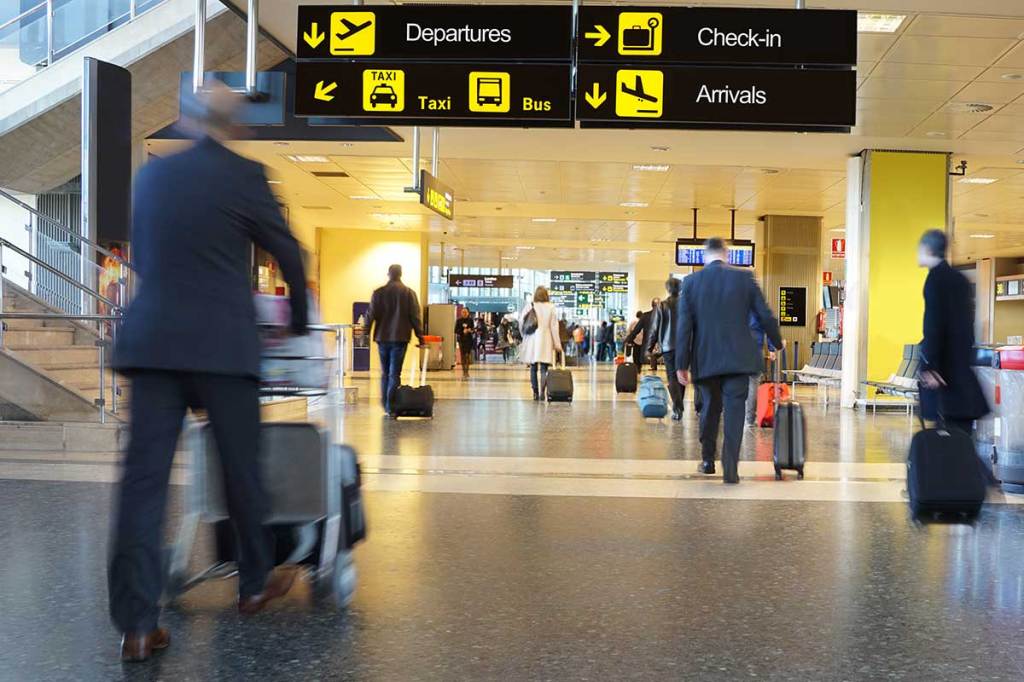Introducing the latest myCWT product and service enhancements
Building on our digital, omnichannel myCWT platform, our new products and services will simplify travel management for you and your employees – anytime, anywhere, anyhow.
Note: Featured services may not be available in your country at this time. Please reach out to your CWT representative for more details.
Hear from Chief Product Officer, Erica Antony as she shares the key product highlights of 2024, along with the key areas driving innovation.
-

2040: Baseline, Boom or Bust
As we enter an era of rapid transformation and unprecedented challenges, it is essential for travel managers, meeting & event planners, and corporate decision-makers to look ahead and frame our current strategic thinking with a clear vision of the future. Business travel and meetings and events (M&E) are poised for significant change over the next decade and a half, driven by a complex interplay of sustainability goals, technological advancements, evolving work models, and geopolitical dynamics.
In this paper to mark the 10th anniversary of our Global Business Travel Forecast, we explore, for the first time, a long-term vision of the future and potential trajectories through three distinct scenarios, each offering insights into how these forces should affect policy-making, budgeting and priorities. By examining these scenarios, we can better understand the diverse possibilities that lie ahead and the strategic imperatives required to thrive in each potential future.
Based on trajectory data analysis and interviews with industry leaders, behaviorists and climate tech founders, this forward-looking approach enables us to anticipate changes, strengthen our strategies, and make informed decisions that align long-term objectives. It is through this lens of foresight and adaptability that we can build resilience, seize opportunities, and navigate the complexities of the future.
We invite you to reflect on the insights presented, and consider how your organization can prepare for the opportunities and challenges that lie ahead. Together we can ensure that travel and meetings remain catalysts for growth, scalability and sustainable practices.
- Scenario development is both an art and a science
- Megatrends Shaping the Future of Business Travel, Meetings and Events
- Sustainability goals the new crux of corporate policy
- Technology Revolutionizes Travel Management
- Modern work models spark new travel patterns
- Changing demographics open doors to new opportunities
- Three Scenarios: Base case, boom and bust
- Future-proofing strategies

-

CWT GBTA Global business travel forecast 2025
When it comes to pricing, global business travel has finally reached an enduring, higher baseline. Prices will continue to rise in 2025, but only moderately, so expect a period of normalized growth.
However, this pricing environment, one of marginal gains and price regularity, is fragile. Global leisure travel has now realized a lot of its pent-up demand, while corporate travel has been resurgent, with 2024 edging at preCovid levels.
There are many factors at play, whether its volatile oil prices, labor costs and constraints, inflationary pressures, and geopolitical factors. As this elevated baseline edges upwards, albeit marginally, travel budgets will come under increased scrutiny, especially as travel patterns and attitudes change.
It’s why business travel can’t be viewed in a silo, and the true value to an organization must be fully realized. This forecast can help with those calculations.

-

Capitalize on emerging technologies in corporate travel
Technological advancements are accelerating at an unprecedented pace. How will emerging innovations like Generative AI, blockchain, and self-sovereign identity (SSI) transform corporate travel?
BTN and CWT probed global CEOs, travel managers, industry consultants and tech experts on the promises, questions, and expectations these innovations raise and how they are set to reshape traveler experience, cost control and service delivery in corporate travel and events.
Download and discover
- The technologies that will have the greatest impact on corporate travel in the next 2-5 years
- How these emerging technologies are poised to control costs, enhance service and security, and boost efficiency
- The critical challenges, opportunities, risks and roadblocks each innovation raises
- What travel managers, buyers and experts anticipate from these innovations

-

Ken Powell Appointed to Carlson Board of Directors
Carlson, Inc., an international travel management company and private investment firm, announces the appointment of Ken Powell to its board of directors, effective April 1, 2020.
Powell is chair of the University of Minnesota board of regents and serves on the boards of directors for Medtronic and Partners in Food Solutions, a nonprofit organization dedicated to helping start-up food companies in Africa. He is the former chairman and chief executive officer of General Mills, where he served in a variety of positions since 1979.
“We are delighted to welcome Ken to the Carlson board of directors,” said Carlson Chair Rick Gage. “Ken’s global perspective, extensive board and leadership experience, and commitment to communities in Minnesota and around the world make him an ideal addition to the Board.”
Powell received a Bachelor of Arts degree in biology from Harvard and an MBA from Stanford University.
Carlson Board of Directors
- Richard Anderson, advisor to the board
- Pamela Arway
- Laura Born
- Jude Buckley
- Kurt Ekert
- Geoffrey Gage
- Rick Gage, Chair
- Scott Gage
- Diana Nelson
- Wendy Nelson
- Ken Powell
- Michael Sweeney
CWT is a leading global partner in business travel, meetings, and events. Operating across six continents, we deliver sustainable, tailored solutions that help organizations connect, engage, and thrive in an evolving world. Our myCWT platform integrates advanced technology with human expertise to simplify travel and enhance traveler and attendee experiences. Extensive global coverage, seamless data integration, AI-driven analytics, and carbon-conscious travel tools enable businesses to optimize their travel and meetings programs while delivering measurable value.
With 150 years of industry experience and a deep commitment to partnership, CWT collaborates with clients to shape the future of business travel and events, making them more efficient, responsible, and impactful.
About Carlson (www.carlson.com)
Now in its third generation of closely held family ownership, Carlson is an international travel management company and private investment firm, operating in nearly 145 countries and territories throughout the world. A global leader in the travel industry, CWT, the B2B4E (business to business for employees) travel management platform, is wholly owned by Carlson and is the foundation of its portfolio of businesses. Carlson Private Capital Partners, a middle-market investment firm, was formed by the Carlson family and launched in 2018 -

Podcast: COVID-19: Business travel in the time of coronavirus
COVID-19, officially a global pandemic, is first and foremost, a human calamity, and one that has upended business travel like never before. In this episode, we talk with Matt Bradley, a former CIA intelligence officer, who is now with International SOS.
We discuss what the leading travel risk services company is advising all clients right now. For those who still need to travel in these unprecedented and unsettling times, find out what you must consider before making that decision. And, while we make no predictions of when this will end, Matt offers his take on how business travel will change post-COVID-19.[buzzsprout episode=’3053773′ player=’true’]
-

The knowledge: Why you should chat to your cab driver
Passengers seem to fall into one of two categories: Those that say nothing to their taxi or ride-sharing driver and those who are unfazed by reading out a text message from their love interest to a complete stranger. After all, who can resist a confession box on wheels?
For many business travelers, a cab ride is a coveted solitary moment between busy meetings and should be experienced in funereal silence. But the benefits of chatting to a driver are plenty.
“Maintaining healthy habits while traveling is nearing the top of the priority list for travelers around the world,” says Niklas Andréen, CWT’s Chief Traveler Experience Officer.
Research points to a boost in feelings of happiness that arise from seemingly trivial encounters with minor characters in our day-to-day lives. Here are three reasons to spark up a conversation with your taxi driver.
- They know everything
If you’re in a new city and you want to know about the political climate or local opinion on an issue, you could read the same news and listings that everyone else sees or you could be an audience of one to the musings of a local expert. Your driver will have seen that political protest first-hand. And she’ll know the precise location of the hottest new bar. - It’s an opportunity for a digital detox
According to research by Rescuetime, we spend an average of three hours and 15 minutes on our phones. There’s no better excuse to put your device down. - Inspiration is everywhere
Because ride-sharing work is flexible, many drivers build their careers around fascinating lives and entrepreneurial endeavors. One driver I had in London last week, was building an app to connect international medical doctors to prospective patients in Nigeria. If you’re looking for field research or innovative ideas to bring to the boardroom, the best place to look may well be the front seat, not the boardroom.
However, if you’re a card-carrying introvert and prefer to stick your headphones in, tune in to Business Travel On The Fly.
In each episode, drivers from London to Singapore weigh in on the latest issues. Find us on iTunes, Spotify, Stitcher or wherever you get your podcasts.
Image credits: Adobe Stock
- They know everything
-

In lieu of flowers: Why are we still celebrating International Women’s Day?
For more than 100 years, March 8th has marked International Women’s Day around the world. It was officially recognized by the U.N in 1977 and has been linked to historical changes in legislation all over the world.
- Now is not the time for complacency “I’ve learned that you shouldn’t go through life with a catcher’s mitt on both hands,” said author and activist Maya Angelou, “you need to be able to throw something back.”
Great strides have been made for equality but there’s a long way to go. It’s shocking how recently some legislation was passed. In the UK where I live, it wasn’t until 1975 that a woman could open a bank account in her own name. It was 1980 before it was possible to apply for a credit card or loan without a husband or father’s signature and 1994 before maternity leave became compulsory.
Women and men have stepped up and fought for women’s rights but we don’t have to dedicate our lives to activism to make a change. Calling out sexist language or taking time to mentor young women over coffee is important. If a woman says something in a meeting and she’s interrupted, we can redirect and amplify her voice by saying: “As Lisa pointed out earlier…” - There’s room for everyone
Some men’s rights activists believe “the efforts to enhance the rights of women have become toxic efforts to undermine the rights of men” This couldn’t be further from the truth.
Studies point to the societal benefits of equality. A report by WHO comparing 41 European countries found that men’s health was poorer where the sexual division of labor was imbalanced. Productivity and wellbeing are better where there’s equality in parental leave or flexible working for all genders. Whether it’s income, gender, race or sexuality, inequality has negative consequences. In the quest for equality, one person’s gain is not another’s loss. - Let’s go the whole mile
As we all know, male and female aren’t the only genders to choose from. So while we’re shooting for equality, let’s spread the love.
Unconscious bias was a concept introduced in a landmark experiment called the Implicit Association Test (IAT) aimed at measuring the unconscious roots of prejudice affecting 90-95% of people. Neuroscientists found that the potential for prejudice is basically hardwired in us and exacerbated by the media. Just look at the spike in crime against people of Chinese ethnicity in the wake of coronavirus. But we can work to reduce our biases and become conscious of how we discriminate.
Say it flowers if you want, hashtag it and phone your mum. But take action too, until the moment to truly celebrate: When we don’t need an International Women’s Day at all.
Image credits: Adobe Stock
- Now is not the time for complacency “I’ve learned that you shouldn’t go through life with a catcher’s mitt on both hands,” said author and activist Maya Angelou, “you need to be able to throw something back.”
-

Travel safety tips for women (and men too)
In preparation for International Women’s Day, we have created a useful infographic with travel safety tips for women (and men too). Download infographic
Image credits: CWT
-

3 ways to stay positive in uncertain times
Two armed robbers were arrested for stealing toilet paper in Hong Kong, Europe just experienced its hottest winter on record and the sight of people riding buses with plastic storage boxes on their heads is becoming the new normal. It’s easy to feel like we’re in uncharted territory without hearing it from the head of the WHO. With the state of the world in flux, how can we continue to find joy?
1. We can make a difference
Without diminishing the gravity of international crises and the need for urgent action to tackle them, it helps to be aware that it’s not all doom and gloom and we have the power to make a difference.
When times are hard, people join forces. Volunteers from around the world knitted mittens for koalas harmed in the Australian wildfires. Wuhan’s citizens’ sang songs from their apartment windows to boost morale during the quarantine. Hard times can bring out the best in us and encourage integrity and community.
2. Follow reputable sources, and have the occasional news fast
Like many people’s relatives, my mother has a talent for disseminating videos from dubious sources. Viral fakes include the passing of celebrities and politicians who are alive and badly photo-shopped species that don’t exist. Unless black lions are a thing? If it’s on the internet it must be true, right?
We can’t always be sure of what’s real. We’re more aware of news stories, particularly harrowing ones, thanks to social media. As author Ta-Nehisi Coates says, “The violence is not new; it’s the cameras that are new.” Instead of guzzling from the tap of tweets, follow a few trustworthy news outlets, unfollow social media accounts that distress you, and access health and travel advice from official sources such as WHO, International SOS, and IATA.
3. Book within your policy and stay connected
With daily changes to international travel likely to continue for the foreseeable, it’s critical that travelers book within their company’s policy. Stay connected by downloading an app from your travel management company like myCWT and follow guidance from your workplace.
Image credits: Adobe Stock
-

CWT appoints David Pitts as VP, Revenue Management
CWT, the B2B4E travel management platform, announces the appointment of David Pitts as Vice President, Revenue Management, Global Supplier Management. David reports to Brian Mogler, Senior Vice President, Global Supplier Management.
“We are pleased to welcome Dave into the team,” said Brian Mogler. “Dave will lead revenue management and data analytics strategy and will be instrumental in driving our value proposition to suppliers.”
Prior to joining the Global Supplier Management team, David served as head of TX (Traveler Experience) Strategic Planning where he was responsible for the analysis and reporting of the team’s operational performance, as well as defining its long-term strategy.
David first joined CWT in 2017 as Director, Enterprise Strategy, where he drove innovation and operational improvement projects throughout the company. Before joining CWT, David served as Senior Manager at Deloitte Consulting.
David holds a Bachelor of Science degree in Mathematics & Statistics from the University of Nebraska-Lincoln.
CWT is a leading global partner in business travel, meetings, and events. Operating across six continents, we deliver sustainable, tailored solutions that help organizations connect, engage, and thrive in an evolving world. Our myCWT platform integrates advanced technology with human expertise to simplify travel and enhance traveler and attendee experiences. Extensive global coverage, seamless data integration, AI-driven analytics, and carbon-conscious travel tools enable businesses to optimize their travel and meetings programs while delivering measurable value.
With 150 years of industry experience and a deep commitment to partnership, CWT collaborates with clients to shape the future of business travel and events, making them more efficient, responsible, and impactful.
-

Travel etiquette: 9 tips that will make you a popular travel buddy
Traveling for most of us, is an exciting experience that broadens the mind. That said, it is true that some trips can become a headache if you encounter inconsiderate travelers along the way.
We share here nine travel etiquette tips from our in-house experts, to help avoid faux pas that might offend other travelers.
- Respect other people’s personal space. this varies country to country, but one thing is universal: nobody likes an armrest invader or a manspreader. When it comes to armrests, the custom dictates one per passenger. Typically, the armrest that has your media and electrical outlets will be the one you use. Exception to the rule, however, is in triple-seat rows, where the middle passenger has rights to both armrests. This is because the window passenger has control of the window shade and the aisle passenger has the ability to stretch their legs. Whereas the middle seat traveler is sandwiched between two travelers and, therefore, outranks in the armrest stakes.
As for reclining, it’s every traveler’s right to do so but a courtesy peek before lowering your seat is crucial. Reclining is a no-go during meal times or if behind you there’s a tall passenger whose knees would be squeezed, if there is a child-in-lap or an open tray table where drinks or a laptop is balanced. - Mind the back of the seat in front of you. Grabbing the back of the seat in front of you as you walk in the aisle or in your row can be unpleasantly jarring to the person sitting in it. Copy the flight attendants who balance themselves in the aisle by grabbing the luggage compartments above their heads, rather than the seat backs.
- Refrain from constant movement. Nervous leg syndrome? Frequent trips to the toilet? Regularly rummaging in the overhead compartment? Up-and-down movement can annoy your fellow passengers, particularly those in your row whose feet you may have trampled. Flight fidgets should always choose an aisle to minimize fellow traveler disruption.
- Don’t climb over sleeping passengers. When you’re on a ten-hour flight, sleep can be your savior. If you are in a middle or aisle seat, alert your neighbors that you will probably fall asleep and how it’s totally fine for them to gently nudge you should they need to vacate their own seat and stretch their legs. This will minimize any worry they may be having about disturbing you. Have also some compassion on the sleepyheads who don’t want to hear about your next meeting. Hushed tones, at all times on flights – no matter the time.
- Read the cues. It is nice to be nice and, sometimes, a long-haul flight can lead, if not to a friendship, to enlightening conversations. Many people, however, enjoy flight anonymity and silence. Keep this in mind before you sit down. If you need to introduce yourself when you sit down to get a feel for the other person’s mood, do so, but if he or she quickly dismisses you by opening a book or pretends to go to sleep, be respectful and stop talking.
- Remember: Smell is the strongest human sense. Perfumes, aftershaves and pungent food are a no go for a flight, no matter how much you love them. A lot of people have chemical sensitivities, so be considerate when everyone is seated close together where scents may aggravate. Embarking a journey in a metal tube with recycled air is no place for anything potent.
- Organize your hand luggage. Put your headphones, medication, tissues and snacks in a ziplocked bag that will go under the seat in front of you or in your seatback pocket. Don’t be that passenger who needs to get into the overhead storage during a flight and dig for items that could well spill over into your neighbor’s lap. Plan and pack ahead when it comes to your in-flight necessities.
- Go with the flow. You are the last one to board and despite being seated in 9F, your luggage can only be stowed in the overhead compartments 15 rows back. This should pose no issue if you have your inflight necessity zip-log bag ready so accept your fate, and go with the flow. If you have a tight connection for your next flight, let the flight attendants know so they can get your bag to you prior to landing. If not, exercise your patience. Wait for other passengers to disembark before retrieving your hand luggage, rather than interrupting and slowing down disembarkation for everyone.
- Be ready. Long queues at security checks are rough. No matter how well you prepare, the line will always be annoying. People will be in a hurry and they will complain. Kids will cry, teenagers will be texting, and the busy business person will be glued to their emails. To ease the journey, dress the part (no jewelry, belts, heels with multiple straps) so that should you need to remove any items that you can easily without holding up the line. Have your liquids and tech ready while in line to place in tray. Essentially there is no shortcut or velvet rope to sneak under so take a Zen approach to the security line and realize patience is a virtue… Namaste.
Image credits: Adobe Stock
- Respect other people’s personal space. this varies country to country, but one thing is universal: nobody likes an armrest invader or a manspreader. When it comes to armrests, the custom dictates one per passenger. Typically, the armrest that has your media and electrical outlets will be the one you use. Exception to the rule, however, is in triple-seat rows, where the middle passenger has rights to both armrests. This is because the window passenger has control of the window shade and the aisle passenger has the ability to stretch their legs. Whereas the middle seat traveler is sandwiched between two travelers and, therefore, outranks in the armrest stakes.
-

All that we share: Standing for zero discrimination
You may already know that, according to the Boston Consulting Group, companies with a more diverse management team have 19% higher revenue, or that McKinsey research shows that racially and ethnically diverse companies outperform industry norms by 35%.
But, did you know that according to Josh Bersin research inclusive companies are 1.7 times more likely to be innovation leaders in their market? Or that researchers from Cloverpop found that effective decision-making increases with greater diversity in a team? All-male teams already outperformed individuals 58% of the time, and the percentage reached 73% for gender-diverse teams and 87% when members were gender and geographically diverse and had at least one age gap of more than 20 years.
Candidates focus on the value of diversity when looking for a new job – indeed Glassdoor reports that 67% of job seekers have it in mind when evaluating offers.
Statistics aside, if you are a global company serving clients of different age, culture, gender, sexual orientation, religion, race, height, weight, profession, education and beliefs, you sure understand the importance of promoting diversity and inclusion within your company.
Each day, no fewer than 18,000 individuals come to work at CWT – and every one of them brings a unique set of ideas, beliefs and skills, shaped by their heritage, background and culture. This melting pot is our most important resource, and we have a duty to protect and nurture it.
It is impossible for any company to meet clients’ needs if they look at the world from a narrow angle, or from a single perspective. Foremost, it is impossible to create a sustainable future without respecting our differences and working towards inclusion.
We are all unique, we are all different, but we all deserve equal treatment.
We need to learn to cherish and nurture differences. They are the spice of life that make everything better and, if you work on your prejudices, you will realize that, deep down, there are more things that unite us than divide us.
And if you are still not convinced, I invite you to watch this old Danish television channel TV 2 spot and discover all that we share. It makes an excellent watching for a Sunday.
Happy Zero Discrimination Day.
Image credits: Adobe Stock
-

Navigating China’s payment systems
Despite coronavirus, which has all but isolated China from business travelers around the globe, it is inevitable that organizations will resume their contacts with the world’s second-largest economy in the near future. When that happens, travelers will again be faced with a payment system that can potentially confuse and frustrate them – unless they prepare in advance.
One of the biggest challenges is that travelers take their ‘standard’ payment methods, usually based around credit cards, so much for granted, they can’t contemplate a situation where plastic is not accepted.
Out with the old, in with the new
China can present a rude shock for the foreign business traveler. Where your credit card may be your best friend everywhere else, in China that’s not the case. This is especially true for international cards from the likes Visa, MasterCard, Amex and Diners, which are not widely accepted in the country.
China has largely leapfrogged the card-based system, and the digital payment systems such as e-wallets and mobile payments have come to dominate most commerce. Even cash, the traditional fallback in most markets, is accepted rather grudgingly by many Chinese vendors.
It is estimated that more than 80% of all payments in China today are made using mobile phones. And of these, over 90% are processed through AliPay and WeChat Pay, the two leading third-party mobile payment providers owned by Chinese tech-giants Alibaba and Tencent respectively.
This has been one of the biggest pain points for international business travelers – because until recently, WeChat Pay and Alipay could not be used without a local Chinese bank account and a local mobile phone line. Late last year, however, both companies announced they would make their services accessible to foreign visitors.
AliPay has added a feature to its app which works similar to a pre-paid card, and can be topped up using international credit cards. Similarly, WeChat Pay has recently been opened up to foreigners, through a collaboration with many of the major global credit card companies.
This means that business travelers visiting China should now be able to use these payment modes for dining, transportation and accommodation, among other things.
Getting ready to pay in China
While you may be able to present your personal or corporate credit cards at an international hotel in a big city like Beijing or Shanghai, it’s best not to assume that your go-to payment methods will work everywhere. When you get to independent hotels or tier two and three cities, for example, you may not have the luxury of being able to pay by card.
The same is true for meals, taxis and other things you will need to pay for on your trip.
Preparing to travel to China requires not only a rethink of payment practices, but also preparing travelers with the right technology. They should make sure they have WeChat Pay and AliPay apps loaded on their devices and have their cards linked to the app, where possible. This also means IT departments may have to ‘white list’ some sites and apps with which they may have little prior experience.
That said, even if you’ve downloaded the apps and linked up your credit cards, it’s advisable not to put all your eggs in this basket. While visiting Shanghai for a conference earlier this year, some of my colleagues found they were unable to link their cards, while others couldn’t make payments even after all the set-up was complete. When the tech fails, cash can come to the rescue. While the cashier may give you a bewildered or disapproving look, they’ll probably still take your money.
A final word of advice – life is easier if you have a local contact (a colleague, a client, a friend), and you keep their contact details handy. That way, if something goes wrong and you don’t speak any Mandarin, they can help you out.
This article was first published on Business Travel News Europe and is republished with permission.
Listen to our podcast: Imagine if expense reporting disappears.
Image credits: Adobe Stock
-

CWT and GBTA Report: Drivers, Opportunities and Constraints to improve sustainability in the travel industry
CWT, the B2B4E travel management platform, and GBTA have published today ‘The Big Idea: How Can We Make Business Travel More Sustainable?’. The report’s findings stem from a large-scale brainstorm session on this topic, hosted during the GBTA Conference 2019 Munich and attended by senior industry professionals representing the travel management companies (TMCs), hotel, air, car and ancillary services, as well as the corporate buyer community from across Europe.

When asked how confident they were on the industry’s ability to make the future of business travel more sustainable, 65% of delegates were either broadly confident or very confident. The percentage grew to 71% when asked about the willingness of the industry.
“At CWT we are seriously committed to being a positive force for change in the world, which is why we did not hesitate to sponsor this important session at GBTA in order to gain first-hand industry feedback around both demand and drivers for sustainable business travel,” said Françoise Grumberg, CWT’s Vice President Global Responsible Business and Diversity & Inclusion. “Our planet is under critical environmental strain and CWT is committed to driving and contributing to industry debate and forums such as this to drive as much positive action as possible.”

Drivers for change, opportunities, and constraints
Four senior leaders from different segments of the travel industry – including Directors and VPs from CWT, Oakwood Worldwide, The LEGO Group and United Airlines – formed the panel who led the debate. Delegates were asked what they believed were the critical drivers for change, key opportunities to improve sustainability, constraints preventing their implementation and what role travelers, buyers, TMCs, airlines and accommodation suppliers play in bringing their ideas to life.
Drivers
The growing social conscience, especially among millennials and centennials, is putting pressure on companies. Traveling employees are demanding a more sustainable travel program. Organizations will need to act if they want to maintain their reputation. Suppliers, on their side, will also need to adapt their offer if they want to remain relevant for a traveler audience who is choosing to book with more environmentally conscious providers.
Opportunities
This mentality change will open the door to more ecofriendly alternatives – biofuel, improved recycling at airports, better waste reduction, eradicating single use plastics, fewer empty flights, modernized aircraft fleets, more ecofriendly cleaning products – that will ultimately lead to a reduction in carbon emissions.
By adopting a proactive approach, combined with state of the art technology and data capacities, TMCs can play a key role in making business travel more sustainable. They can assist companies to create a greener travel program by helping them to choose the best suppliers, by offering carbon reports and by crafting travel policies around gamification and reward systems for those employees who are more conscious.
Constraints
The identified constraints ranged from employer apathy to a perceived lack of alternative options. The implementation cost of more sustainable air and accommodation options as well as a lack of reporting or measurement were also identified as impediments.
“In the end, pressure from the traveler will translate into positive action. Advancements in technology will be required to help solve the more complex environmental issues such as the guest accommodation experience and carbon neutrality in the aviation industry but opportunities are aplenty to work with supply chains who already implement and track sustainable practices across the customer journey,” said Scott Solombrino, GBTA’s COO and Executive Director. “As an industry, we need to work together to find some solutions to help corporate travelers to make the right decisions when traveling on business.”
CWT is a leading global partner in business travel, meetings, and events. Operating across six continents, we deliver sustainable, tailored solutions that help organizations connect, engage, and thrive in an evolving world. Our myCWT platform integrates advanced technology with human expertise to simplify travel and enhance traveler and attendee experiences. Extensive global coverage, seamless data integration, AI-driven analytics, and carbon-conscious travel tools enable businesses to optimize their travel and meetings programs while delivering measurable value.
With 150 years of industry experience and a deep commitment to partnership, CWT collaborates with clients to shape the future of business travel and events, making them more efficient, responsible, and impactful.
-

What are our biggest travel gripes and can technology solve them?
If you asked people thirty years ago for the most unlikely inventions in travel, they might say driverless cars, facial recognition technology or robots. All of these things are here already.
Plus, one can book a flight using a screenshot from Instagram and several companies have tested passenger drones. We’re increasingly un-phased by technological advances and we’re excited by the pace of change. Our research reveals that 71% of global business travelers embrace travel innovation.
Yet, we still grapple with tiny tubes of face cream in airport security lines.
We asked Rachel O’Brien, Chief Technology Officer at CWT about the biggest pain points for business travelers. They often come down to the basics, “Airport security is one,” she says, “Being informed can take the sting out of airport drudgery. So real-time apps, giving travelers a heads up on security guidelines, wait-times, flight delays, weather conditions at the airport and what can be carried onto your flight – can help to ease commuter friction. But it’s the streamlining of airport security that every frequent traveler fantasizes about.”
Biometric technology has the answers: “Through a combination of gateless boarding, mobile passports, visa management and mobile global entry, the most anticipated part of a business trip should begin at the airport rather than once you exit customs.”
Traveler safety is another key challenge that technology should be able to provide a solution to, says Rachel. Navigation apps like RedZone that allow users to see and report incidents and unsafe situations go some way to meeting the needs of solo travelers, however the ability to plan around risk remains outstanding, “Nothing provides alerts and guidance of what to do if the risk in your vicinity increases.”
The corporate travel industry would do well to learn from other sectors, “There are disrupters and challenger start-ups taking creative, ‘greenfield’ and agile approaches to solving problems and prioritizing user-experience,” says Rachel, “One example is Lumo which predicts flight disruptions and proactively tries to help passengers rebook. It’s not always household names that inspire – it’s those brands that really understand the technology and trends that may seep into the landscape in corporate travel, now and in the future.”
Image credits: Adobe Stock